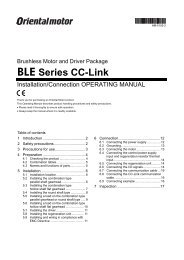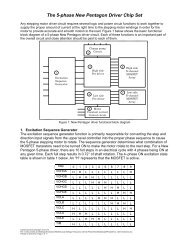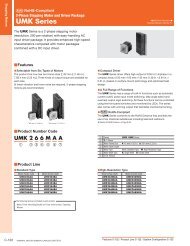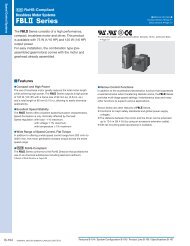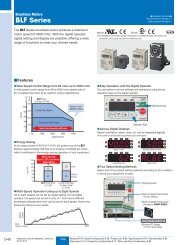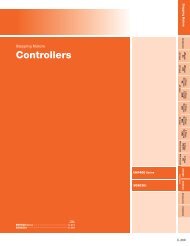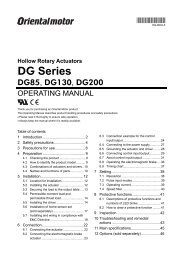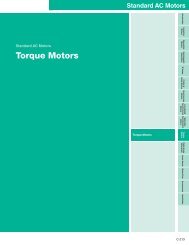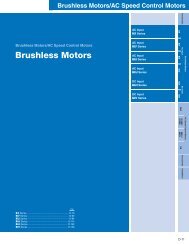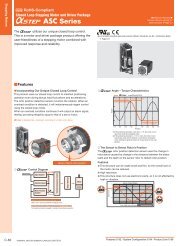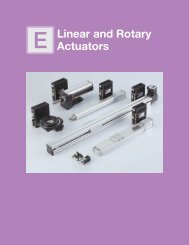Product Reference - Oriental Motor
Product Reference - Oriental Motor
Product Reference - Oriental Motor
You also want an ePaper? Increase the reach of your titles
YUMPU automatically turns print PDFs into web optimized ePapers that Google loves.
Technical <strong>Reference</strong><br />
■Stepping <strong>Motor</strong> Drivers<br />
There are two common systems of driving a stepping motor:<br />
constant current drive and constant voltage drive.<br />
The circuitry for the constant voltage drive is simpler, but it’s<br />
relatively more difficult to achieve torque performance at high<br />
speeds.<br />
The constant current drive, on the other hand, is now the most<br />
commonly used drive method, since it offers excellent torque<br />
performance at high speeds. All <strong>Oriental</strong> <strong>Motor</strong>’s drivers use the<br />
constant current drive system.<br />
●Overview of the Constant Current Drive System<br />
The stepping motor rotates through the sequential switching of<br />
current flowing through the windings. When the speed increases, the<br />
switching rate also becomes faster and the current rise falls behind,<br />
resulting in lost torque.<br />
The chopping of a DC voltage that is far higher than the motor’s<br />
rated voltage will ensure the rated current reaches the motor, even at<br />
higher speeds.<br />
VCC<br />
Tr2<br />
●Differences between AC Input and DC Input<br />
Characteristics<br />
A stepping motor is driven by a DC voltage applied through a driver.<br />
In <strong>Oriental</strong> <strong>Motor</strong>’s 24 VDC input motor and driver packages,<br />
24 VDC is applied to the motor. In the 100-115 VAC motor and driver<br />
packages the input is rectified to DC and then approximately<br />
140 VDC is applied to the motor. (Certain products are exceptions to<br />
this.)<br />
This difference in voltages applied to the motors appears as a<br />
difference in torque characteristics at high speeds. This is due to<br />
the fact that the higher the applied voltage is, the faster the current<br />
rise through the motor windings will be, facilitating the application of<br />
rated current at higher speeds. Thus, the AC input motor and driver<br />
package has superior torque characteristics over a wide speed<br />
range, from low to high speeds, offering a large speed ratio.<br />
It is recommended that AC input motor and driver packages, which<br />
are compatible with a wider range of operating conditions, be<br />
considered for your applications.<br />
150<br />
1.2<br />
1.0<br />
100-115 VAC<br />
24 VDC<br />
0 V<br />
Pulse-Width<br />
Control Circuit<br />
Voltage Comparison<br />
Circuit<br />
<strong>Reference</strong> Voltage<br />
I<br />
<strong>Motor</strong> Winding<br />
Tr1<br />
Current Detecting Resistor<br />
The current flowing to the motor windings, detected as a voltage<br />
through a current detecting resistor, is compared to the reference<br />
voltage. Current control is accomplished by holding the switching<br />
transistor Tr2 ON when the voltage across the detecting resistor<br />
is lower than the reference voltage (when it hasn’t reached the<br />
rated current), or turning Tr2 OFF when the value is higher than<br />
the reference voltage (when it exceeds the rated current), thereby<br />
providing a constant flow of rated current.<br />
Voltage<br />
Vcc<br />
t0<br />
Current<br />
I<br />
t1<br />
Time<br />
t0<br />
t1 Time<br />
Voltage - Current Relationship in Constant Current Chopper Drive<br />
Torque [oz-in]<br />
100<br />
50<br />
0<br />
Torque [N·m]<br />
0.8<br />
0.6<br />
0.4<br />
0.2<br />
0<br />
0 1000 2000 3000 4000<br />
Speed [r/min]<br />
0<br />
10<br />
20<br />
30 (Resolution: 500)<br />
(0) (100) (200) (300) (Resolution: 5000)<br />
Pulse Speed [kHz]<br />
●Microstep Drive Technology<br />
Microstep drive technology is used to divide the basic step angle<br />
(0.72˚) of the 5-phase stepping motor into smaller steps (up to a<br />
maximum of 250 divisions) without the use of a speed reduction<br />
mechanism.<br />
◇Microstep Drive Technology<br />
The stepping motor moves and stops in increments of the step angle<br />
determined by the rotor and stator’s salient pole structure, easily<br />
achieving a high degree of precision in positioning. The stepping<br />
motor, on the other hand, causes the rotor speed to vary because<br />
the motor rotates in step angle increments, resulting in resonance or<br />
greater vibration at a given speed.<br />
Microstepping is a technology that achieves low resonance, low<br />
noise operation at extremely low speeds by controlling the flow of<br />
electric current fed to the motor coil and thereby dividing the motor’s<br />
basic step angle into smaller steps.<br />
· The motor’s basic step angle (0.72˚/full step) can be divided into<br />
smaller steps ranging from 1/1 to 1/250. Microstepping thus<br />
ensures smooth operation.<br />
· With the technology for smoothly varying the motor drive current,<br />
motor vibration can be minimized for low noise operation.<br />
◇Up to 250 Microsteps<br />
Thanks to the microstep driver, different step angles (16 steps up<br />
to 250 divisions) can be set to two step angle setting switches. By<br />
controlling the input signal for step angle switching via an external<br />
source, it is possible to switch the step angle between the levels set<br />
for the respective switches.<br />
F-50 ORIENTAL MOTOR GENERAL CATALOG 2009/2010



